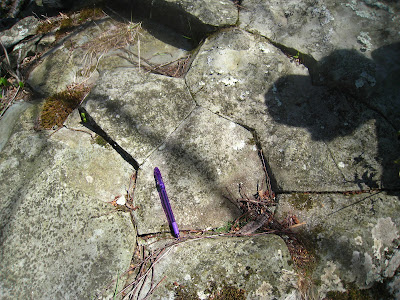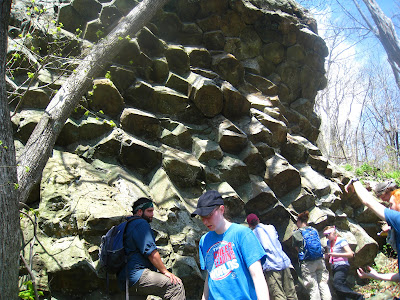On March 30th, my structural geology class went on another day trip, this time to Thoroughfare Gap. It's a gap in Bull Run Mountain by I-66, Rt 55, and the Manassas Gap Railroad. This area is the beginning of the Blue Ridge and the end of the Piedmont province. We were to take the orientation of bedding, joints, and veins that were formed by the Appalachian mountain building. From the data that is gathered, we are to determine the orientation form which the stress came.
 |
| View from look out on Bull Run Mountain. |
I'm going to start with a brief geologic history of the area. The supercontinent Rodinia was formed by the Grenville orogeny resulting in the proto-Appalachians. As Rodinia was rifting apart about 700 Ma, the Iapetus ocean was forming. Sediment from the proto-Atlantic was being eroded due to the rifting and deposited in the new ocean. This is called passive margin sedementation. This process created the Chilhowee Group. The Chilhowee Group consists of the Harpers, Weverton, and the Atietam formations. The Weverton is the lowest of the group and is overlain the the Harpers and then the Antietam. The Harpers and Weverton are seen at Throughfare Gap.
The supercontinent Pangea formed as Africa collided with North America in what is known as the Alleghenian Orogeny. This happened approximately 325 Ma. As a result, the Iapetus Ocean closed. This was the beginning of the mountain chain that is the Appalachians. But all supercontinents must come to an end. The break up of Pangea lead to the formation the the Atlantic Ocean. This happened through spreading of normal fault basins. Not all areas of spreading may form a full rifting sequence. The Culpepper Basin is an example of this. It did not keep spreading and it filled with dirt. Had it been the rifting of the Atlantic that failed, the area of the Culpepper Basin would be a vast ocean.
When we arrived to Thoroughfare Gap, we took a hike up Bull Run Mountain. The majority of the rocks that we had seen were primarily Weverton sandstone. The sandstone is a quartz arenite which is a clean beach sandstone. The beds were all dipping to the east. We also saw some kinked phyllite.
 |
| Kinked phyllite. |
When we got to the overlook, we stopped for lunch and admired to the view. You could see straight across to the Blue Ridge were we were to take our next field trip for the class.
 |
| View as we ate lunch. |
After lunch, we took some orientations of the beds and quartz veins around the overlook. I had one measurement for the beds- 010°, 75°- and two measurements of quartz veins- 020°, 80° and 005°, 87°. After about half an hour at the outlook, we headed back down the trail. The next stop was to an outcrop that was full of joints. We followed the Manassas Gap Railroad tracks down to the outcrop.
 |
| Following the railroad tracks. |
When we arrived at the outcrop, we set off to measure the orientations of the joints, veins, and bedding.
 |
| Class measuring orientations at the outcrop. |
 |
| Milky quartz vein. |
From the data gathered, we were to determine how many joint sets there were. The class shared their data and I put all the data in a stereonet.
 |
| Joints potted on stereonet. |
Even though this does look very crowded, I prefer it that way so that I can see a trend among the data. I see three sets of joints in this stereonet.
 |
| Trends of joints. |
I also plotted the bedding and veins on a stereonet.
 |
| Bedding plotted on stereonet. |
 |
| Veins plotted on stereonet. |
I noticed that the orientation of the bedding and the veins are very similar. I thought that the veins would have an orientation more like the joints because they are essentially "healed" joints.

















































